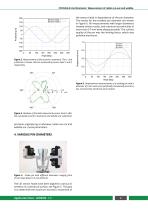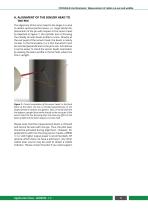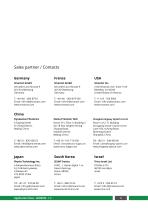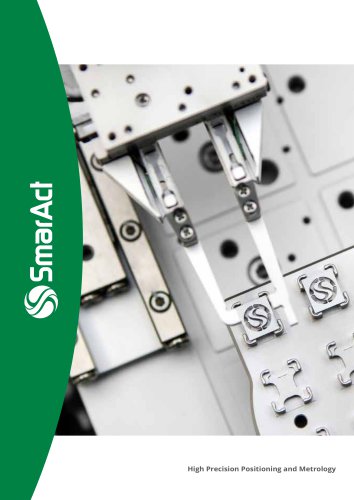 Website:
SmarAct GmbH
Website:
SmarAct GmbH
Catalog excerpts

PICOSCALE Interferometer: Measurement of radial run-out and wobble Abstract The PICOSCALE Interferometer is a displacement sensor with picometer resolution. It may be applied in industrial applications to measure (and eventually correct) the radial run-out of a rotating workpiece or spindle. experiments (Order Code: PS-CTRL-V1.4-HP), which is optimal for low-reflectivity or cylindrical targets. Figure 1. Schematic view of the setup. PICOSCALE sensor heads are used to characterize the motion of a rotating target, which could be a sample holder in synchrotron beamlines. 1. INTRODUCTION In high precision engineering or in synchrotron endstations the precise knowledge of the movement of a rotating target is of crucial interest. Radial run-out and wobble of a rotating spindle may have significant influence on the quality of a workpiece, and thus needs to be reduced. In synchrotron applications, tomography of crystal structures requires even higher precision to accurately position the sample. Thus the run-out and wobble need to be measured accurately. Subsequently, by applying adequate control loops or lookuptables, the rotating target may be kept on the desired trajectory. 2. SETUP The setup of this demonstrator is shown in Figure 2. A polished cylinder (stainless steel) was mounted on a SmarAct xy-stage as well as a rotary stage. The xystage can either be used to set a specific eccentricity to prove the capability of measuring large run-outs of up to 1 mm, or to correct for it. Two line focusing sensor heads (Order Code: PS-SH-L01) were assembled at a specific height with a 90◦ orientation to measure the eccentricity, and a third sensor head was mounted above the second one. The latter pair was used to infer the wobble of the cylinder. A PICOSCALE Controller with increased laser power was used for these Figure 2. Experimental setup. Three PICOSCALE sensor heads with line focused probe beam are targeting a polished cylinder, which is mounted on an xy- and a rotary stage. See text for details. 3. MEASUREMENT PROCEDURE The cylinder was rotated by small increments and at each angle the relative displacement of the target with respect to each sensor head was recorded. In Figure 3 the values for the x- and y-direction are shown. The 90◦ phase shifted signal is (in first order) interpreted as the eccentricity of the sample. The wobble is calculated from the position data of sensor heads 2 and 3. Consequently, a numerical fit is applied to the data that incorporates the wobble of the pin. Thus the effect that each sensor head records the shape of an ellipse instead of a circle is taken into account. The residues from the pin are due to the non-perfect surface of the pin which is overlaid with bearing errors. Figure 4 shows these residues of sensor head 1, for all recorded angles between 0 and 360◦ . The residues are within ±1.5 µm. The line focusing heads allowed to track eccentric movements of up to 1 mm while being insensitive to wobble. Thus, the PICOSCALE c
Open the catalog to page 1
PICOSCALE Interferometer: Measurement of radial run-out and wobble the sensor head in dependence of the pin diameter. The results for the smallest pin diameter are shown in Figure 6. All measurements with larger diameters showed similar results, and maximum eccentricities of more than 0.7 mm were always possible. The surface quality of the pin was the limiting factor, which was polished aluminum. Sensor head 1 Sensor head 2 Figure 3. Measurement of the eccentric movement. The x- and y-direction is shown, that are measured by sensor head 1 and 2, respectively. Figure 4. Residues of the data...
Open the catalog to page 2
PICOSCALE Interferometer: Measurement of radial run-out and wobble A. ALIGNMENT OF THE SENSOR HEAD TO THE PIN The alignment of the senor head to the target is crucial to obtain optimal performance, i.e. large lateral displacements of the pin with respect to the sensor head. As depicted in Figure 7, the cylinder lens is focusing the initially circular beam profile to a line. Directly at the exit pupil of the sensor head, the beam is nearly circular. In the focal plane, it is a thin line which must be oriented perpendicular to the pin’s axis. Sometimes it can be easier to check the sensor...
Open the catalog to page 3
Germany SmarAct GmbH Schuette-Lanz-Strasse 9 26135 Oldenburg Germany T: +49 441 - 800 879 0 Email: info-de@smaract.com www.smaract.com China Dynasense Photonics 6 Taiping Street Xi Cheng District, Beijing, China T: +86 10-835 038 53 Email: info@dyna-sense.com www.dyna-sense.com France SmarAct GmbH Schuette-Lanz-Strasse 9 26135 Oldenburg Germany T: +49 441 - 800 879 956 Email: info-fr@smaract.com www.smaract.com Natsu Precision Tech Room 515, Floor 5, Building 7, No.18 East Qinghe Anning Zhuang Road, Haidian District Beijing, China T: +86 18-616 715 058 Email: chenye@nano-stage.com...
Open the catalog to page 4All SmarAct GmbH catalogs and technical brochures
-
SMARPOD P-SLC-24
2 Pages
-
PLF3232-xy.60
1 Pages
-
CATALOG 2024
188 Pages
-
Catalog 22
182 Pages
-
CGO-60.5
2 Pages
-
CLS-3232
1 Pages
-
CHS-3232-1D-5
2 Pages
-
SR-1908
1 Pages
-
CLL42
1 Pages
-
SmarAct Catalog 20
212 Pages
-
DLS-3232
1 Pages
-
SR-2812-CR
1 Pages
-
CHS-5237-1D10N-10
1 Pages
-
SR-3211
1 Pages
-
SLS-3232
1 Pages
-
Sensor Head C03
4 Pages
-
Sensor Head F01
4 Pages
-
Sensor Head C01
4 Pages























